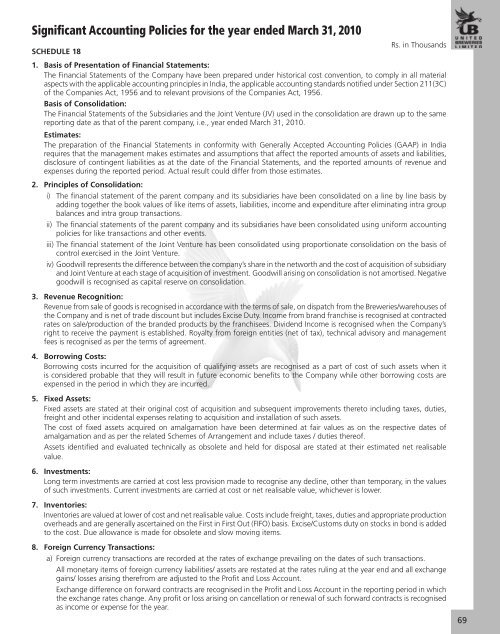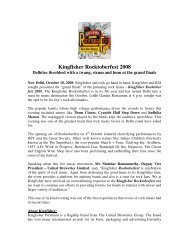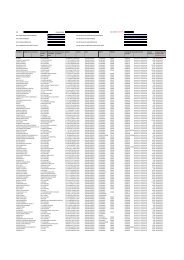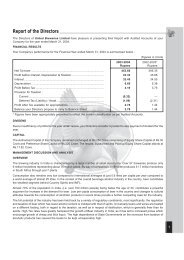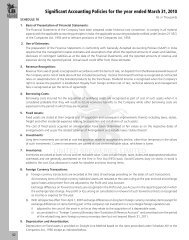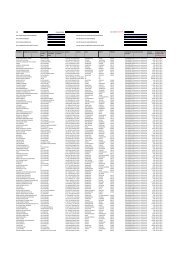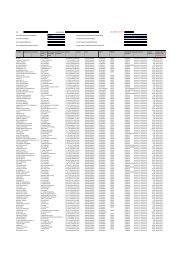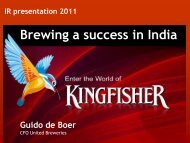Annual Report 2009-10 - United Breweries Limited
Annual Report 2009-10 - United Breweries Limited
Annual Report 2009-10 - United Breweries Limited
You also want an ePaper? Increase the reach of your titles
YUMPU automatically turns print PDFs into web optimized ePapers that Google loves.
Significant Accounting Policies for the year ended March 31, 20<strong>10</strong>Rs. in ThousandsSCHEDULE 181. Basis of Presentation of Financial Statements:The Financial Statements of the Company have been prepared under historical cost convention, to comply in all materialaspects with the applicable accounting principles in India, the applicable accounting standards notified under Section 211(3C)of the Companies Act, 1956 and to relevant provisions of the Companies Act, 1956.Basis of Consolidation:The Financial Statements of the Subsidiaries and the Joint Venture (JV) used in the consolidation are drawn up to the samereporting date as that of the parent company, i.e., year ended March 31, 20<strong>10</strong>.Estimates:The preparation of the Financial Statements in conformity with Generally Accepted Accounting Policies (GAAP) in Indiarequires that the management makes estimates and assumptions that affect the reported amounts of assets and liabilities,disclosure of contingent liabilities as at the date of the Financial Statements, and the reported amounts of revenue andexpenses during the reported period. Actual result could differ from those estimates.2. Principles of Consolidation:i) The financial statement of the parent company and its subsidiaries have been consolidated on a line by line basis byadding together the book values of like items of assets, liabilities, income and expenditure after eliminating intra groupbalances and intra group transactions.ii) The financial statements of the parent company and its subsidiaries have been consolidated using uniform accountingpolicies for like transactions and other events.iii) The financial statement of the Joint Venture has been consolidated using proportionate consolidation on the basis ofcontrol exercised in the Joint Venture.iv) Goodwill represents the difference between the company’s share in the networth and the cost of acquisition of subsidiaryand Joint Venture at each stage of acquisition of investment. Goodwill arising on consolidation is not amortised. Negativegoodwill is recognised as capital reserve on consolidation.3. Revenue Recognition:Revenue from sale of goods is recognised in accordance with the terms of sale, on dispatch from the <strong>Breweries</strong>/warehouses ofthe Company and is net of trade discount but includes Excise Duty. Income from brand franchise is recognised at contractedrates on sale/production of the branded products by the franchisees. Dividend Income is recognised when the Company’sright to receive the payment is established. Royalty from foreign entities (net of tax), technical advisory and managementfees is recognised as per the terms of agreement.4. Borrowing Costs:Borrowing costs incurred for the acquisition of qualifying assets are recognised as a part of cost of such assets when itis considered probable that they will result in future economic benefits to the Company while other borrowing costs areexpensed in the period in which they are incurred.5. Fixed Assets:Fixed assets are stated at their original cost of acquisition and subsequent improvements thereto including taxes, duties,freight and other incidental expenses relating to acquisition and installation of such assets.The cost of fixed assets acquired on amalgamation have been determined at fair values as on the respective dates ofamalgamation and as per the related Schemes of Arrangement and include taxes / duties thereof.Assets identified and evaluated technically as obsolete and held for disposal are stated at their estimated net realisablevalue.6. Investments:Long term investments are carried at cost less provision made to recognise any decline, other than temporary, in the valuesof such investments. Current investments are carried at cost or net realisable value, whichever is lower.7. Inventories:Inventories are valued at lower of cost and net realisable value. Costs include freight, taxes, duties and appropriate productionoverheads and are generally ascertained on the First in First Out (FIFO) basis. Excise/Customs duty on stocks in bond is addedto the cost. Due allowance is made for obsolete and slow moving items.8. Foreign Currency Transactions:a) Foreign currency transactions are recorded at the rates of exchange prevailing on the dates of such transactions.All monetary items of foreign currency liabilities/ assets are restated at the rates ruling at the year end and all exchangegains/ losses arising therefrom are adjusted to the Profit and Loss Account.Exchange difference on forward contracts are recognised in the Profit and Loss Account in the reporting period in whichthe exchange rates change. Any profit or loss arising on cancellation or renewal of such forward contracts is recognisedas income or expense for the year.69


